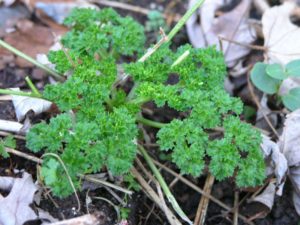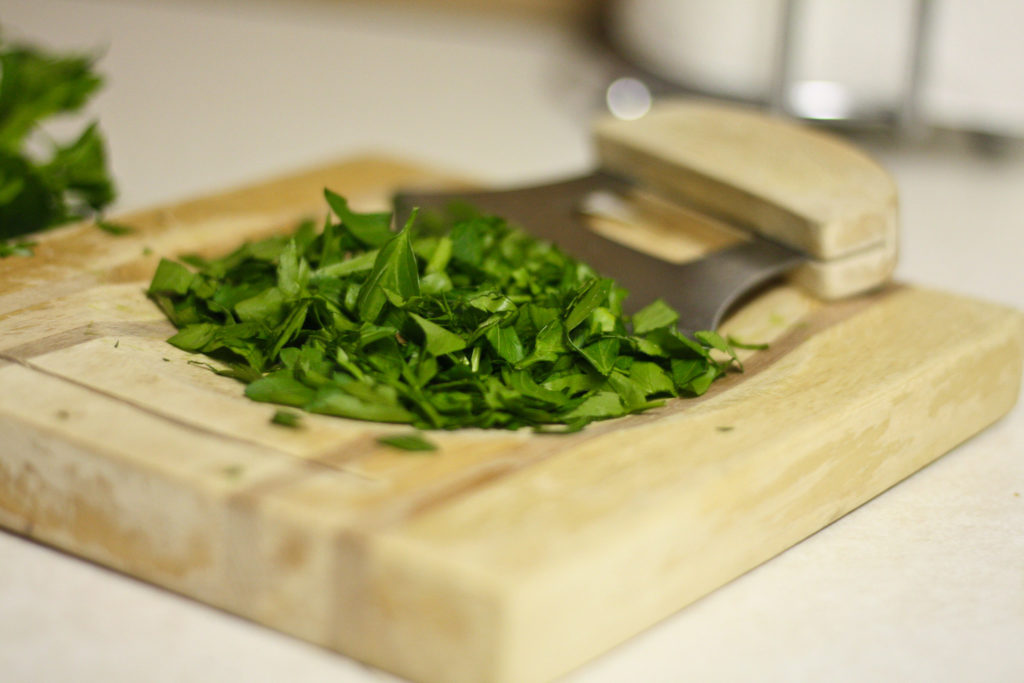Most people tend to think of parsley as a garnish, but it can actually be used in soups, salads, and sauces to add flavor and reduce the reliance on salt. Parsley has a unique flavor profile. It is slightly bitter with earthy tones that can bring flavor balance to savory dishes. The two main types of parsley are flat-leaf and curly-leaf. Flat-leaf varieties are more commonly used in cooking because of its bold flavor and curly-leaf is more commonly used as a garnish. Parsley also has a tremendous number of vitamins and minerals, especially high doses of vitamin A, C, and K. It also has a lot of myricetin, which is a flavonoid also found in cranberries, blackcurrants, and sweet potatoes. Myricetin is known for having anti-cancerous properties!
How To Plant Parsley

Growing parsley can be a little bit tricky as it has a low germination rate and delicate taproots. To get started, try soaking your seeds in water for a few hours before planting as this should help increase your odds of success. Sow your seeds 6-8 weeks before the last Spring frost if you’re starting indoors. Sow seeds 3 weeks before the last frost if you’re starting outside as parsley is a late starter.
Seeds should be sown a quarter inch deep and 6 to 8 inches apart. Keep the soil moist while seeds germinate, so we recommend watering about 1 inch worth of water every week. It will take about 2 to 4 weeks for seedlings to sprout. Parsley needs full to partial sun for growth. If you started your parsley indoors, make sure to utilize growing lights a few inches above each parsley tray. If you’re adding fertilizer to your parsley, a 5-5-5 npk organic fertilizer is generally the way to go. After the seeds germinate, parsley requires 70-90 days until it is mature and ready to harvest.
If you started indoors be extra delicate while transplanting as the parsley taproot is prone to damage during transplant. Growing parsley in containers is also a good option. Parsley grown in containers will require a container at least 10 inches deep and wide so the parsley roots have room to spread out.
Parsley does not tolerate colder climates and prefers temperatures above 70 degrees. It’s ideal growing zones are 5-9.
Harvesting Your Parsley
After 70-90 days your parsley should be ready for harvest. A great indicator that your parsley is ready to harvest is when you see at least three leaf segments. Always trim from the outer stem of the plant. If you cut from the inner stem, you risk causing harm to the parsley plant and reducing yield. After each harvest it should take an additional 2 to 3 weeks for regrowth.
After your harvest we recommend using the parsley while it’s fresh. If you prefer to store the parsley, put each stalk in a small dish of water and put it in the refrigerator. Parsley in water should last up to a week at most. Another option is to dry your parsley. While drying does reduce the flavor, it will extend the shelf life considerably. Hang your parsley in a paper bag in a cool area with proper airflow. The parsley is ready to collect once it crumbles to the touch.

Parsley Pest and Diseases
Aphids are the most common pest found infesting parsley. Pruning and removing damaged parsley is your first line of defense. If required apply neem oil to kill off aphids.
Swallowtail moth larvae can be particularly nasty. They develop into caterpillars that will consume all your parsley. Utilizing pesticides with the bacillus thuringiensis (BT) bacteria should clear up these caterpillars.
Powdery mildew is a common fungus found on parsley. Characterized by its white fluffy dust residue, powdery mildew is managed using copper-based fungicides.
A variety of leaf spot diseases can afflict parsley. These fungi can be managed with copper-based fungicides or by pruning away the affected areas.


Contact Author
 info@gardensavvy.com
info@gardensavvy.com Recent Posts
- Smart Gardening: How Technology Is Revolutionizing Horticulture
- Understanding Gardening Zones: What You Need to Know
- The Right Tools For Your Gardening And Landscaping Needs
- Maximizing Your Harvest: Square Foot Gardening Chart for Beginners
- Holiday Garden Scents: Plants for Natural Aromatherapy in Your Home









